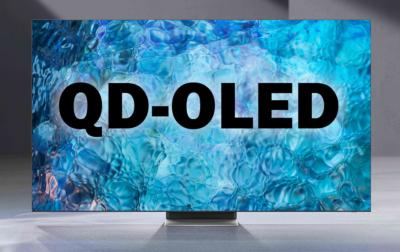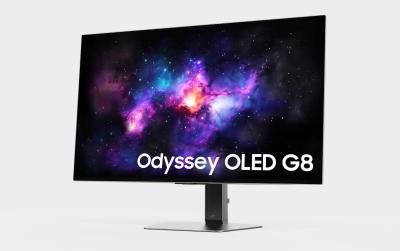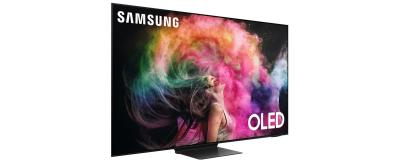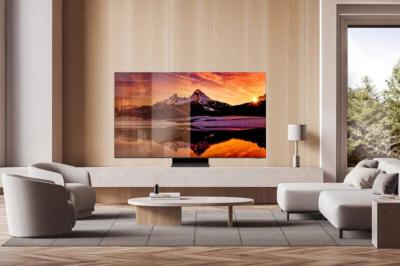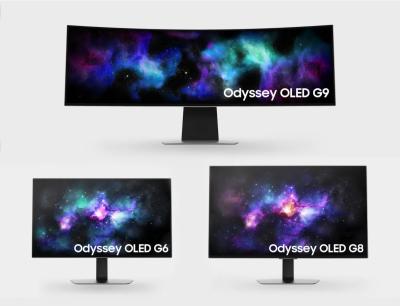OLED displays are made from organic emitter materials - and are gaining in popularity as these next-generation displays offer excellent image quality and novel form factors.
Quantum Dots are tiny particles that have excellent photonic emission properties - and are used widely today in many LCD displays as the QD photoluminescence features enable the conversion of blue LED light to red and green light to create full-color displays that are better than white-backlit LCDs. QD particles can also be used to create emissive displays, in which the QDs themselves emit the light - read more about QD displays here.
QD-OLED displays are hybrid displays that use a combination of OLED emitters with QD color conversion layers and/or QD emitters. The basic idea is that the display uses only blue OLED emitters, and the QD layers conversts some of the pixels to red and green, thus creating a full color display.
Samsung QD-OLED
Samsung is the only company that have commercialized QD-OLED displays (at least until now). Samsung's QD Displays use blue OLED emitters and quantum-dots that convert the blue light to red and green light. In 2019 Samsung Display announced its decision to invest $10.85 billion in QD-OLED TV R&D and production lines. A few years later, SDC started to produce panels in its first fab, mass producing TV and monitor QD-OLEDs.
Samsung attracted several customers (Sony and Samsung Electronics for TV panels, and several companies for its monitors), and these displays have been very well received by the market. Samsung is currently producing around a million QD-OLED panels per year. The future roadmap of Samsung's QD-OLED displays is not clear.
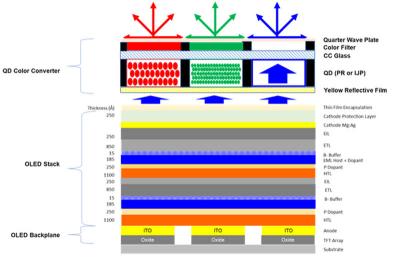
TCL H-QLED
In 2019 it was unveiled that China-based display maker TCL is developing a new hybrid display technology that uses a blue OLED emitter coupled with red and green QD emitters. All three emitter materials will be combined and printed using ink-jet printing technology.
TCL callקג this technology H-QLED and said that this could prove to be the technology of choice for TCL's future high-end emissive TV displays. For more information on TCL's H-QLED, click here. The company, however, did not update on its H-QLED technology since 2019.
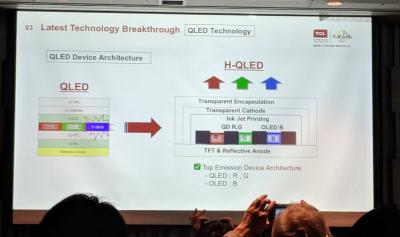
Samsung sold over 20,000 of its new QD-OLED gaming monitors in a month
Samsung Electronics says that a it has sold over 20,000 units of its new QD-OLED monitors, the Odyssey G8 and G6 in a month. The company says that the new monitors are popular in Europe, North America - and Southeast Asia.
A couple of months ago IDC says Samsung is leading the OLED monitor market, with a 34.7% market share by revenue (and 28.3% market share by shipments. Samsung Electronics started selling OLED monitors in 2023.
Samsung Display says it shipped over a million QD-OLED monitor panels
Samsung Display announced that it shipped over a million QD-OLED monitor panels. SDC started producing these panels in 2022, and is currently offering a wide range of panels, from 27-inch to 49-inch, mostly targeting gaming monitors. SDC is working with 10 monitor producers, that have released over 90 QD-OLED monitor models.
Samsung says that it plans to expand its QD-OLED market, by targeting professional monitors and content creation monitors.
Samsung shows its latest OLED and QD-EL displays at Displayweek 2024
Samsung Display had a rather large booth at Displayweek 2024, showing its latest OLED displays and technologies. Samsung showed several displays - including foldable smartphone panels, laptop and tablet displays, two QD-OLED displays, its 9.4" round automotive AMOLED, and more.
One interesting display was a panel that combines a foldable and a rollable display, that can open up to an impressively large display. Samsung brands it as a Flex Note Extendable Display.
LG Display to increase its WOLED panel shipments to Samsung, will reach almost 1 million units in 2024
According to a new report in Korea, LG Display aims to increase its OLED TV panel shipments to Samsung Electronics in 2024, and to reach almost 1 million units.
Samsung has recently signed a five-year OLED TV panel supply agreement with LG Display, as the two Korean companies are increasing their collaboration to fend off competition from China.
Will Samsung decide to abandon its QD-OLED technology?
In 2019 Samsung Display announced its decision to invest $10.85 billion in QD-OLED TV R&D and production lines. A few years later, SDC started to produce panels in its first fab, mass producing TV and monitor QD-OLEDs. The company attracted several customers (Sony and Samsung Electronics for TV panels, and several companies for its monitors), and these displays have been very well received by the market.
Since 2022, Samsung has increased its production yields, and increased its production capacity, and today it produces around 40,000 substrates a month in its 8.5-Gen production line. Reviews of QD-OLED gaming monitors and TVs are very positive, with many analysts seeing QD-OLED as improving over LGD's WOLED panels in terms of image quality.
But the reality at Samsung Display's QD-OLED division, is likely not so rosy. It seems that the technology is facing both market challenges and technology challenges - which may lead to a decision by Samsung to abandon it altogether.
Samsung Display increases focus on small and medium AMOLED production
A report from Korea suggests that SDC has transferred around 500 of its engineers from its large-area OLED development division, or about 30% of them, to its divisions that focus on small and medium-sized AMOLED development.
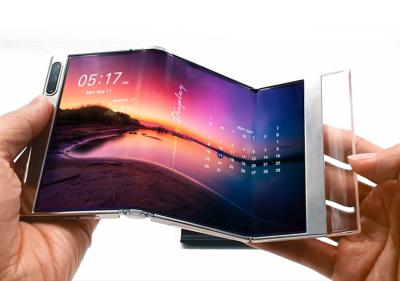
Samsung tri-folding AMOLED prototype
According to the report, the main reason for SDC's change of priorities is due to the need to remain competitive with Chinese-based OLED makers that are offering OLED panels at low costs. Samsung estimates that it is ahead of its Chinese competitors by only a year or a year and half, and it is just a matter of time until Chinese companies catch up with South Korea makers (SDC and LGD).
Samsung's upcoming S90D OLED TV lineup will feature displays utilizing both WOLED QD-OLED panels
According to reports from Korea, LG Display requested Samsung Electronics to use its WOLED panels on the same tier as SDC's QD-OLED panels, and Samsung will use both panel technologies in its S90D OLED TV series. Samsung will likely not disclose the actual panel technology to the consumer, and will likely decide on the panel technology per region.
The Samsung S90D will offer 42-, 48-, 55-, 65-, 77- and 83-inch panels. SDC only makes 55, 65, and 77-inch QD-OLED panels, and so in these sizes both QD-OLEDs and WOLEDs will be used. For the 42-, 48- and 83- models Samsung will only use WOLEDs.
Samsung: we sold 1 million OLED TVs in 2023 and had a market share of 22.7% in the OLED TV market
Samsung announced that in 2023 it retained its market-leading position in the TV mraket, with a 30.1% market share (revenues). The company also disclosed that it sold 1.01 million OLED TVs in 2023 - mostly QD-OLED TVs, and some WOLED TVs as well.
Samsung quotes Omdia saying that it had a 22.7% market share in the OLED TV Market (by revenue), which is pretty impressive, as the company is relatively very new to this market.
Samsung unveils its 2024 OLED TV lineup
Samsung Electronics announced its 2024 OLED TV lineup, with 3 series. The company's flagship OLED TV for 2024, the S95D, offers 55-, 65-, or 77-inch 4K 144hz QD-OLED panels, offering high brightness (up to 3000 nits peak brightness), a new anti-glare coating to minimize reflections, Tizen 8.0 OS, and an external One Connect box for a sleek design. The S95D offers AI-Enhanced color accuracy - validated by Pantone.
Samsung also announced two more series - S90D and S85D. Interestingly, it did not detail whether these TVs use QD-OLED (produced by SDC) or WOLED panels (produced by LGD) - or a mix as it did last year within the same series.
Samsung announces its 2024 QD-OLED gaming monitor range
Samsung Electronics announced their upcoming 2024 QD-OLED gaming monitor range. It starts with the flagship Odyssey G9 (G95SD) gaming monitor that offers a curved 49-inch 32:9 5120x1440 240Hz QD-OLED panel.
The other two monitors offer a flat panel. The Odyssey G6 is a 27-inch 1440p monitor that offers very fast 360Hz refresh rate, while the Odyssey G8 (model G80SD) is a larger monitor, with a 32" 240Hz QD-OLED panel.
Pagination
- Page 1
- Next page
